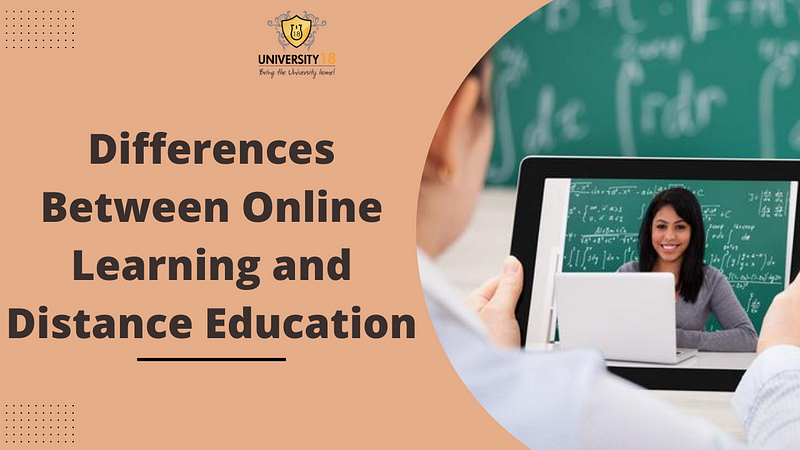Differences Between Online Learning and Distance Education

Learners unable to do regular studies for career, training, or any other such reasons turn to distance education. It helps them to manage study, indeed. The two of the main options of distance mode in the undergrad and postgrad studies are — distance and online existing globally. Both are different from each other, with one common feature that they provide education remotely. As online is recent, the roots of distance go back a long way.

Let’s have an overview of the differences between both models. It shall lead you to opt for the one that suits you the best.
Distance learning
In the mid-19 Century, distance learning evolved in the western world serving the needs of the working class employed but interested in improving their level of education. The model soon gained popularity for the convenience it offered and became embedded in the higher-level educational sector of every country worldwide.
In distance learning basically, students:
- Do not need to physically visit the college for pursuing a degree or course..
- Do not get lectures from an educator.
- Receive self-learning materials from their college.
- Give semestrial exams and gain their degree.
It is the model in which a student gets learning material through a post. It is the most traditional form of distance education.
In the distance mode students would have to:
- Physically visit the college for the admission processes.
- Receive printed learning materials for self-study through a post at the registered address.
- Give yearly exams from a center organized by their college.
Advancing through the time since its inception the distance learning model has transformed from the traditional and come up in a new role called online learning or e-learning.
Online learning
Online-education is the product of the digital era. It is the period when people have easy access to the internet. They are computer literate and keen to use technology in doing maximum of their work from booking online tickets, shopping, to attaining education.
Today, the utility of the model is not hidden from us. During the covid pandemic locked-down time it was e-learning that kept the studies unstoppable for the school kids to the college students.
Online learning has caused a boom in the education industry. From small skill-enhancing to degree courses are pursuable online. The ICT powered e-learning model has emerged as the most comprehensive and convenient way of learning. Acknowledging its usefulness, the mode has earned recognition as an authorized education mode in distance learning.
Let’s know why students are inclining more towards the e-mode. Studying under this mode you:
- Get admission without physically travelling to the institute or college.
- Study from the online provided e-learning material (pdf, videos, and ppts).
- Learn through live or recorded lectures, depending on the design of the course offered by a particular institute.
- Give exams from your location, no need to travel to a centre or college.
- Receive your degree or certificates online.
Hence, from admission to earning the degree, the whole learning process takes place online.
Distance and Online: Differences
Conceptually both online and distance education serve the same purpose, they facilitate remote learning. However, they vary in some structural and functional aspects. Let’s see how:
Online Learning
Parameters
Distance Learning
It depends on the e-learning model.
Some designs offer student-teacher interaction while others completely do not.
Student-teacher Interaction
It does not take place.
Learners do not need to visit the campus for admission.
It’s solely online.
From finding a college to attaining a degree everything takes place online.
location
Learners visit the campus for admission registration.
Learners access the study material online provided by the institution.
They are provided comprehensive study material in the forms of pdf files, ppts, lecture videos, and extra study links.
Learning Material
Learners receive the study material through a post.
They may visit their college to collect the notes.
Learners attempt semestrial and other exams online.
Examination
Learners have to appear at a centre organized by the college to give semestrial exams.
The degree is globally recognised if earned from a college/institution accredited under the UGC regulations for the online mode.
Degree Value
Degree is considered valid if earned from a college/institution formed under the UGC regulations.
Institutions provide online chat and calling support to students facing any issues.
24/7 Chat Support
Students would approach a desk representative available in the college during office hours only.
Learners can opt for a graduate, postgraduate, diploma, or certificate course online.
Universities are offering various streamlined degree and diploma courses online.
Online Courses
Learners can do a graduate, postgraduate, diploma, or certificate course through correspondence.
The century-old University of mysore of Karnataka recently came in news that it has got AICTE approval on its 19 MBA and 2 other diploma and certificate courses each. It’s a state university and ranks 19th in the NIRF-MHRD Ranking of 2021. The institute is accredited for offering education online under the UGC regulation. Degrees earned under the online mode from the college are acknowledged globally.
Post Your Ad Here
Comments